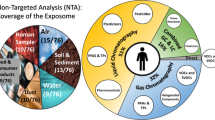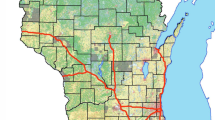Abstract
The use and advantages of high-resolution mass spectrometry (MS) as a discovery tool for environmental chemical monitoring has been demonstrated for environmental samples but not for biological samples. We developed a method using liquid chromatography–quadrupole time-of-flight MS (LC–QTOF/MS) for discovery of previously unmeasured environmental chemicals in human serum. Using non-targeted data acquisition (full scan MS analysis) we were able to screen for environmental organic acids (EOAs) in 20 serum samples from second trimester pregnant women. We define EOAs as environmental organic compounds with at least one dissociable proton which are utilized in commerce. EOAs include environmental phenols, phthalate metabolites, perfluorinated compounds, phenolic metabolites of polybrominated diphenyl ethers and polychlorinated biphenyls, and acidic pesticides and/or predicted acidic pesticide metabolites. Our validated method used solid phase extraction, reversed-phase chromatography in a C18 column with gradient elution, electrospray ionization in negative polarity and automated tandem MS (MS/MS) data acquisition to maximize true positive rates. We identified “suspect EOAs” using Agilent MassHunter Qualitative Analysis software, to match chemical formulas generated from each sample run with molecular formulas in our unique database of 693 EOAs assembled from multiple environmental literature sources. We found potential matches for 282 (41%) of the EOAs in our database. Sixty-five of these suspect EOAs were detected in at least 75% of the samples; only 19 of these compounds are currently biomonitored in National Health and Nutrition Examination Survey. We confirmed two of three suspect EOAs by LC–QTOF/MS using a targeted method developed through LC–MS/MS, reporting the first confirmation of benzophenone-1 and bisphenol S in pregnant women’s sera. Our suspect screening workflow provides an approach to comprehensively scan environmental chemical exposures in humans. This can provide a better source of exposure information to help improve exposure and risk evaluation of industrial chemicals.
This is a preview of subscription content, access via your institution
Access options
Subscribe to this journal
Receive 6 print issues and online access
$259.00 per year
only $43.17 per issue
Buy this article
- Purchase on Springer Link
- Instant access to full article PDF
Prices may be subject to local taxes which are calculated during checkout




Similar content being viewed by others
References
Muir DC, Howard PH . Are there other persistent organic pollutants? A challenge for environmental chemists. Environ Sci Technol 2006; 40: 7157–7166.
US Environmental Protection Agency. Chemical Data Reporting Fact Sheet: Chemicals Snapshot. USEP Agency 2012.
Centers for Disease Control and Prevention. National Health and Nutrition Examination Survey Hyattsville, MD (cited 30 July 2013). Available from http://www.cdc.gov/nchs/nhanes.htm.
Kumar E, Holt WV . Impacts of endocrine disrupting chemicals on reproduction in wildlife. Adv Exp Med Biol 2014; 753: 55–70.
Rogers JM, Ellis-Hutchings RG, Grey BE, Zucker RM, Norwood J Jr., Grace CE et al. Elevated blood pressure in offspring of rats exposed to diverse chemicals during pregnancy. Toxicol Sci 2014; 137: 436–446.
Marmugi A, Lasserre F, Beuzelin D, Ducheix S, Huc L, Polizzi A et al. Adverse effects of long-term exposure to bisphenol A during adulthood leading to hyperglycaemia and hypercholesterolemia in mice. Toxicology 2014; 325: 133–143.
Knower KC, To SQ, Leung YK, Ho SM, Clyne CD . Endocrine disruption of the epigenome: a breast cancer link. Endocr Relat Cancer 2014; 21: T33–T55.
Kay VR, Bloom MS, Foster WG . Reproductive and developmental effects of phthalate diesters in males. Crit Rev Toxicol 2014; 44: 467–498.
Sobolewski M, Conrad K, Allen JL, Weston H, Martin K, Lawrence BP et al. Sex-specific enhanced behavioral toxicity induced by maternal exposure to a mixture of low dose endocrine-disrupting chemicals. Neurotoxicology 2014; 45: 121–130.
Judson R, Richard A, Dix DJ, Houck K, Martin M, Kavlock R et al. The toxicity data landscape for environmental chemicals. Environ Health Perspect 2009; 117: 685–695.
Andra SS, Austin C, Patel D, Dolios G, Awawda M, Arora M . Trends in the application of high-resolution mass spectrometry for human biomonitoring: an analytical primer to studying the environmental chemical space of the human exposome. Environ Int 2017; 100: 32–61.
Aceña J, Stampachiacchiere S, Pérez S, Barceló D . Advances in liquid chromatography-high-resolution mass spectrometry for quantitative and qualitative environmental analysis. Anal Bioanal Chem 2015; 407: 6289–6299.
Schymanski EL, Singer HP, Slobodnik J, Ipolyi IM, Oswald P, Krauss M et al. Non-target screening with high-resolution mass spectrometry: critical review using a collaborative trial on water analysis. Anal Bioanal Chem 2015; 407: 6237–6255.
Cappiello A, Famiglini G, Palma P, Termopoli V, Lavezzi AM, Matturri L . Determination of selected endocrine disrupting compounds in human fetal and newborn tissues by GC-MS. Anal Bioanal Chem 2014; 406: 2779–2788.
Hsu JY, Hsu JF, Chen YR, Shih CL, Hsu YS, Chen YJ et al. Urinary exposure marker discovery for toxicants using ultra-high pressure liquid chromatography coupled with Orbitrap high resolution mass spectrometry and three untargeted metabolomics approaches. Anal Chim Acta 2016; 939: 73–83.
Lacorte S, Fernandez-Albaz AR . Time of flight mass spectrometry applied to the liquid chromatographic analysis of pesticides in water and food. Mass Spectrom Rev 2006; 25: 866–880.
Chiaia-Hernandez AC, Krauss M, Hollender J . Screening of lake sediments for emerging contaminants by liquid chromatography atmospheric pressure photoionization and electrospray ionization coupled to high resolution mass spectrometry. Environ Sci Technol 2013; 47: 976–986.
Hernandez F, Portoles T, Ibanez M, Bustos-Lopez MC, Diaz R, Botero-Coy AM et al. Use of time-of-flight mass spectrometry for large screening of organic pollutants in surface waters and soils from a rice production area in Colombia. Sci Total Environ 2012; 439: 249–259.
Pitarch E, Portoles T, Marin JM, Ibanez M, Albarran F, Hernandez F . Analytical strategy based on the use of liquid chromatography and gas chromatography with triple-quadrupole and time-of-flight MS analyzers for investigating organic contaminants in wastewater. Anal Bioanal Chem 2010; 397: 2763–2776.
Rager JE, Strynar MJ, Liang S, McMahen RL, Richard AM, Grulke CM et al. Linking high resolution mass spectrometry data with exposure and toxicity forecasts to advance high-throughput environmental monitoring. Environ Int 2016; 88: 269–280.
Hogenboom AC, van Leerdam JA, de Voogt P . Accurate mass screening and identification of emerging contaminants in environmental samples by liquid chromatography-hybrid linear ion trap Orbitrap mass spectrometry. J Chromatogr A 2009; 1216, p510–519.
Pugajeva I, Rusko J, Perkons I, Lundanes E, Bartkevics V . Determination of pharmaceutical residues in wastewater using high performance liquid chromatography coupled to quadrupole-Orbitrap mass spectrometry. J Pharm Biomed Anal 2017; 133: 64–74.
Nacher-Mestre J, Serrano R, Portoles T, Berntssen MH, Perez-Sanchez J, Hernandez F . Screening of pesticides and polycyclic aromatic hydrocarbons in feeds and fish tissues by gas chromatography coupled to high-resolution mass spectrometry using atmospheric pressure chemical ionization. J Agric Food Chem 2014; 62: 2165–2174.
Gerona RR, Woodruff TJ, Dickenson CA, Pan J, Schwartz JM, Sen S et al. Bisphenol-A (BPA), BPA glucuronide, and BPA sulfate in midgestation umbilical cord serum in a Northern and Central California population. Environ Sci Technol 2013; 47: 12477–12485.
US Environmental Protection Agency. ToxCast 2010 (cited 1 August 2010). Available from http://epa.gov/ncct/toxcast/.
US Environmental Protection Agency. TSCA Chemical Substance Inventory Washington, DC (cited 29 April 2011). Available from http://www.epa.gov/oppt/existingchemicals/pubs/tscainventory/basic.html.
US Environmental Protection Agency. Non-confidential 2006 IUR Company/Chemical Records, US Environmental Protection Agency: Washington, DC; 2010 (5/20 cited 2014). Available from http://cfpub.epa.gov/iursearch/.
US Environmental Protection Agency. Chemical Data Reporting (CDR): US Environmental Protection Agency; 2012 (cited 17 December 2014). Available from http://www.epa.gov/cdr/.
CDC (Centers for Disease Control and Prevention). Fourth National Report on Human Exposure to Environmental Chemicals. US Department of Health and Human Services, Centers for Disease Control and Prevention: Atlanta, GA 2009.
TEDx. TEDX List of Potential Endocrine Disruptors 2011 (30 August 2013). Available from http://www.endocrinedisruption.com/endocrine.TEDXList.overview.php.
Office of Environmental Health and Hazard Assessment. Safe Drinking Water and Toxic Enforcement Act of 1986. Chemicals Known to the State to Cause Cancer or Reproductive Toxicity (Proposition 65 List) (cited 14 April 2010). Available from http://www.oehha.org/prop65/prop65_list/files/P65single040210.pdf.
Agilent Pesticides Personal Compound Database Library v 4.1 2012.
US Department of Health and Human Services FaDA, Center for Drug Evaluation and Research (CDER), Center for Veterinary Medicine (CVM). Guidance for Industry: Bioanalytical Method Validation, US Department of Health and Human Services, Food and Drug Administration: Silver Spring, MD 2001.
Dufour P, Pirard C, Charlier C. Validation of a novel and rapid method for the simultaneous determination of some phenolic organohalogens in human serum by GC-MS. J Chromatogr B Analyt Technol Biomed Life Sci 2016; 1036–1037: 66–75.
Acknowledgements
We thank the staff and faculty at San Francisco General Hospital Women’s Options Center for their assistance in blood sample collection. We also thank Katie Stevenson, Dylan Atchley, Mei-Lani Bixby and Cynthia Megloza for their assistance in recruitment and data collection, and Shorey Myers and Clayton Bloszies for their assistance in putting together the EOA database. This project was supported by NIH grants P20 ES018135, R21 ES017763, R01 ES013527, R01HD31544, R01 ES027051, P01 ES022841 (funded jointly by NIEHS and the US Environmental Protection Agency), EPA RD-83543301, EPA RD-83564301, California EPA P0050869 and the Passport Foundation.
Author information
Authors and Affiliations
Corresponding author
Ethics declarations
Competing interests
The authors declare no conflict of interest.
Additional information
Supplementary Information accompanies the paper on the Journal of Exposure Science and Environmental Epidemiology website
Supplementary information
Rights and permissions
About this article
Cite this article
Gerona, R., Schwartz, J., Pan, J. et al. Suspect screening of maternal serum to identify new environmental chemical biomonitoring targets using liquid chromatography–quadrupole time-of-flight mass spectrometry. J Expo Sci Environ Epidemiol 28, 101–108 (2018). https://doi.org/10.1038/jes.2017.28
Received:
Accepted:
Published:
Issue Date:
DOI: https://doi.org/10.1038/jes.2017.28
Keywords
This article is cited by
-
Standardizing non-targeted analysis reporting to advance exposure science and environmental epidemiology
Journal of Exposure Science & Environmental Epidemiology (2023)
-
Gaussian graphical modeling of the serum exposome and metabolome reveals interactions between environmental chemicals and endogenous metabolites
Scientific Reports (2021)
-
Examining NTA performance and potential using fortified and reference house dust as part of EPA’s Non-Targeted Analysis Collaborative Trial (ENTACT)
Analytical and Bioanalytical Chemistry (2020)
-
Using prepared mixtures of ToxCast chemicals to evaluate non-targeted analysis (NTA) method performance
Analytical and Bioanalytical Chemistry (2019)



